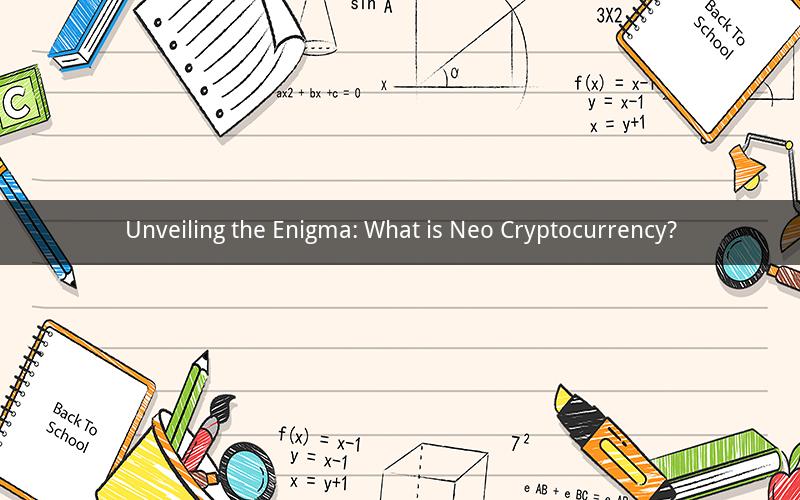
Introduction:
The world of cryptocurrencies has been evolving rapidly, with numerous digital currencies emerging in recent years. One such cryptocurrency that has gained significant attention is Neo. Known for its unique features and potential, Neo has sparked curiosity among investors and enthusiasts alike. In this article, we will delve into the intricacies of Neo cryptocurrency, exploring its origins, technology, use cases, and future prospects.
1. Origins of Neo Cryptocurrency
Neo, often referred to as the "Chinese Ethereum," was founded by Da Hongfei and Erik Zhang in 2014. The project was inspired by the vision of creating a decentralized, open-source platform that would facilitate the development of smart contracts and decentralized applications (DApps). It aims to bridge the gap between traditional businesses and the blockchain technology.
2. Technology and Architecture
Neo utilizes a dual-token model, consisting of Neo (NEO) and GAS. The NEO token represents ownership and governance rights within the Neo ecosystem, while the GAS token serves as the network's fuel for transactions and smart contract execution.
The Neo platform is built on a unique architecture that combines the principles of blockchain technology with digital identity and digital assets. It utilizes a Delegated Byzantine Fault Tolerance (dBFT) consensus algorithm, which ensures fast and secure transaction processing without the need for Proof of Work (PoW).
3. Neo's Unique Features
a. Smart Contracts: Neo's primary focus is on enabling the development and deployment of smart contracts. These self-executing contracts automatically enforce agreements and eliminate the need for intermediaries, reducing costs and increasing efficiency.
b. Digital Identity: Neo incorporates digital identity into its platform, allowing users to securely manage their digital identities and verify their identities for various applications.
c. Interoperability: Neo aims to bridge the gap between different blockchain platforms by promoting interoperability. This feature enables seamless interaction between different blockchains, fostering collaboration and innovation.
4. Use Cases of Neo Cryptocurrency
a. Smart Contracts: Neo's smart contract capabilities have been utilized for various applications, including decentralized finance (DeFi), supply chain management, and digital identity verification.
b. Decentralized Applications (DApps): Developers can build DApps on the Neo platform, leveraging its robust infrastructure and user-friendly programming environment.
c. Cross-Chain Integration: Neo's interoperability feature allows for the integration of different blockchains, facilitating the transfer of assets and data between platforms.
5. Future Prospects of Neo Cryptocurrency
a. Market Adoption: As more businesses and developers embrace the Neo platform, its market adoption is expected to grow, potentially increasing its value and usage.
b. Competition: Neo faces competition from other blockchain platforms, such as Ethereum and Binance Smart Chain. However, its unique features and focus on interoperability may give it a competitive edge.
c. Regulatory Environment: The regulatory landscape for cryptocurrencies is continuously evolving. Neo's compliance with regulatory requirements and its commitment to transparency may help it thrive in the long run.
6. Neo Cryptocurrency: A Comprehensive FAQ
Question 1: What is the difference between NEO and GAS tokens?
Answer 1: NEO tokens represent ownership and governance rights within the Neo ecosystem, while GAS tokens serve as the network's fuel for transactions and smart contract execution.
Question 2: How does Neo's dBFT consensus algorithm work?
Answer 2: Neo's dBFT consensus algorithm allows for fast and secure transaction processing by selecting a set of validators to produce blocks, reducing the need for Proof of Work (PoW).
Question 3: Can I use Neo to develop my own smart contract?
Answer 3: Yes, Neo's platform is designed for the development and deployment of smart contracts, making it an ideal choice for developers looking to create decentralized applications.
Question 4: Is Neo more secure than other cryptocurrencies?
Answer 4: Neo's dBFT consensus algorithm and robust architecture make it a secure platform. However, like any cryptocurrency, it is essential to take appropriate security measures to protect your assets.
Question 5: What are the potential risks associated with investing in Neo?
Answer 5: Investing in cryptocurrencies, including Neo, carries risks such as market volatility, regulatory changes, and technological vulnerabilities. It is crucial to conduct thorough research and consult with financial advisors before making investment decisions.
Conclusion:
Neo cryptocurrency has emerged as a compelling player in the world of digital currencies, offering unique features and potential for innovation. With its focus on smart contracts, digital identity, and interoperability, Neo has the potential to revolutionize various industries. As the platform continues to evolve and gain market adoption, it is worth keeping an eye on its future prospects.